Is it possible to create a successful consumer brand without community?
I recently re-listened to an interview where I chatted with OLIO co-founder Saasha Celestial-One about their community led business.
OLIO has more than 8.7 million global community members, volunteers and ambassadors.
It calls itself ‘the feel-good sharing app’, helping people and businesses to reduce food waste and household item waste by sharing or passing unwanted things on to others.
The problems they are solving include:
- £15 billion of edible food thrown away every year by UK households
- 33% of food produced globally is wasted
- 800 million people going to bed hungry every night
- 50% of the clothes in our wardrobes are never worn
- 65% of greenhouse gases are caused by household consumption
I’m a huge fan of OLIO and the positive impact that it has had over the past 10 years. As well as being a carbon negative company, the numbers speak for themselves:
- 15 million household items shared
- 125 million meals shared
- 982 million car miles taken off the road
Learn more about OLIO, the vision, the numbers and its impact on the world here.
I met and interviewed Saasha a couple of years ago, but her comments about how successful communities create business moats, hold true today.
I asked her whether she defined OLIO as a community-led business, and whether she felt that there was any other way to do business as a consumer brand.
“One of the things that bothers me is when people throw the word ‘community’ around when I'm not sure that they have authentically built their own community or nurtured a true community.
It is one of those words like “revolution” that’s so overused that it can become meaningless.
There are certainly loads of businesses that are incredibly successful who are using the word “communities” as a shortcut for their social media followers. But they're just not the same to me.
A community isn’t something that is solely anchored around a social media handle. It’s not that you can’t build dialogue and engagement in social media. Take a direct to consumer brand. They're selling people subscriptions, and then they might have an abstract of social media following, but I wouldn't say they necessarily have a community, but they can still be successful.
What a community does is to give you defensibility. When the next consumer shift comes, having a community adds significantly to brand loyalty and defensibility. Community provides a protective moat against competition. People can stick with the community a lot longer than they'll stick with a product or service.
It's hard to build a community and there are certainly best practices but it's not something where you can do ABC and D and then all of a sudden people talk to each other spontaneously and your refer-a-friend or your NPS is off the charts and everyone's talking about it.
I think people can build a successful business, but it might not be as defensible as one that has invested in building and nurturing a community.”
OLIO ambassadors in action. These vital community members collect and distribute food that would usually be wasted.
The OLIO app lets local people pass on household items as well as surplus food.
Photo credit: Francis Augusto
Book a Free Consultation
Have a community that isn't quite working as it should. Looking for community training? Want help developing a community-led business, launching or growing a community? Whether its a Minimal Viable Community (MVC) or a larger community project, I’m ready and waiting to hear from you. Book an introductory call.



